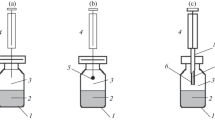Abstract
This paper aims to improve the signal response in headspace (HS) analysis over than the GC analysis with a classical splitless injection mode, and this was achieved by the development of high-pressure headspace (HP-HS) analysis method. Based on the theoretical analysis on the sampling principle of HS, the HP-HS concept was proposed in section one, indicative of possibility to achieve excellent signal response. In the proposed HP-HS technology, the complete transfer of gas sample from HS to GC column is achieved in a very short purge-off time in the splitless injection of GC using the high-pressure carrier gas. The sampling size was increased by adopting high-pressure auxiliary gas. The dilution effect of venting process on detected substance was greatly reduced by controlling the terminal pressure of venting process at a high level. With the HP-HS analysis technology, the optimal equilibration temperature and signal response for analytes with high or medium volatility in ten common solvents was determined, and the results showed that the HP-HS-GC method can achieve very high signal response and very low solvent effect on GC. For aqueous samples, the signal response of HP-HS-GC can be up to three times than that of the splitless GC analysis. The present technology has a great potential, in particular, in high sensitivity analysis of complicated samples with serious substrate effect.









Similar content being viewed by others
References
Kolb B, Ettre LS (2006) Static headspace-gas chromatography: theory and practice, 2nd edn. John Sons, Hoboken, New Jersey
Diekmann JA III, Cochran J, Hodgson JA, Smuts J (2020) Quantitation and identification of ethanol and inhalant compounds in whole blood using static headspace gas chromatography vacuum ultraviolet spectroscopy. J Chromatogr A 1611:460607
Hu HC, Zhang Y, Zeng T, Zhou W, Chen L, Huang L, Ni Y (2018) Determination of cellulose derived 5-hydroxymethyl-2-furfural content in lignocellulosic biomass hydrolysate by headspace gas chromatography. Cellulose 25(7):3843–4385
Arroyo-Manzanares N, García-Nicolás M, Castell A, Campillo N, Viñas P, López-García I, Hernández-Córdoba M (2019) Untargeted headspace gas chromatography-Ion mobility spectrometry analysis for detection of adulterated honey. Talanta 205:120123
Hu HC, Zhang S, Zeng T, Lin Y, Huang L, Chen L, Ni Y (2018) Determination of γ-valerolactone content in its synthesis and biorefinery processes by headspace analysis technique. Fuel 224:17–22
Shapira A, Berman P, Futoran K, Guberman O, Meiri D (2019) Tandem mass spectrometric quantification of 93 terpenoids in cannabis using static headspace injections. Anal Chem 91(17):11425–11432
Zheng Y, Hu Z, Tu X, Wu K, Chen G, Chai XS (2020) In situ determination of the observed yield coefficient of aerobic activated sludge by headspace gas chromatography. J Chromatogr A 1610:460560
Tu X, Hu Z, Zhao T, Chai X, Wang J, Chen G (2019) High throughput determination of the organic matter content in soil and municipal sludge by headspace gas chromatography. Anal Methods 11(47):5963–5968
Zhang C, Hu H, Chai X, Pan L, Xiao X (2014) Determination of maximal amount of minor gases adsorbed in a shale sample by headspace gas chromatography. J Chromatogr A 1328:80–84
Snow NH, Bullock GP (2010) Novel techniques for enhancing sensitivity in static headspace extraction-gas chromatography. J Chromatogr A 1217(16):2726–2735
Kolb B (1999) Headspace sampling with capillary columns. J Chromatogr A 842(1):163–205
Antoine Ch (1888) Tension des vapeurs: nouvelle relation entre les tension et les temperatures. Comptes Rendus 107(681):684
Liu CT, Lindsay WT Jr (1970) Vapor pressure of D2O from 106 to 300 ºC. J Chem Eng Data 15(4):510–513
Hirata M, Suda S (1967) Vapor pressure on methanol in high pressure regions. Kagaku Kogaku 31(4):339–342
Ambrose D, Sprake CHS, Townsend R (1975) Thermodynamic properties of organic oxygen compounds XXXVII vapour pressures of methanol, ethanol, pentan-1-ol, and octan-1-ol from the normal boiling temperature to the critical temperature. J Chem Thermodyn 7(2):185–190
Ganeff JM, Jungers JC (1948) Tensions de vapeur du systeme CH3Cl-CH2Cl2. Bull Soc Chim Belg 57(1 3):82–87
Ambrose D, Townsend R (1963) Thermodynamic properties of organic oxygen compounds part 9 the critical properties and vapour pressures, above five atmospheres, of six aliphatic alcohols. J Chem Soc 3614:3625
Ambrose D, Sprake CHS, Townsend R (1974) Thermodynamic properties of organic oxygen compounds XXXIII the vapour pressure of acetone. J Chem Thermodyn 6(7):693–700
Ambrose D, Broderick BE, Townsend R (1967) The vapour pressures above the normal boiling point and the critical pressures of some aromatic hydrocarbons. J Chem Soc A 633:641
Polák J, Mertl I (1965) Saturated vapour pressure of methyl acetate, ethyl acetate, n-propyl acetate, methyl propionate, and ethyl propionate. Collect Czech Chem Commun 30(10):3526–3528
Williamham CB, Taylor WJ, Pignocco JM, Rossini FD (1945) Vapor pressures and boiling points of some paraffin, alkylcyclopentane, alkylcyclohexane and alkylbenzene hydrocarbons. J Res Natl Bur Stand 35(3):219–244
Acknowledgements
The authors acknowledge the Natural Science Foundation of China (31700507, 21576105), the National Key Research and Development Program of China (2017YFB0307900), and the FAFU’s Fund for Distinguished Young Scholars (XJQ201601) to sponsor this research.
Funding
The authors have not disclosed any funding.
Author information
Authors and Affiliations
Corresponding author
Ethics declarations
Conflict of Interest
The authors have not disclosed any competing interests.
Ethical Approval
This article does not contain any studies with human participants performed by any of the authors.
Additional information
Publisher's Note
Springer Nature remains neutral with regard to jurisdictional claims in published maps and institutional affiliations.
Rights and permissions
About this article
Cite this article
Yang, J., Zeng, T., Xu, H. et al. Achieving Higher Signal Response Than Splitless GC Injection by High-Pressure Headspace Sampling and Full Evaporation Technique. Chromatographia 85, 507–517 (2022). https://doi.org/10.1007/s10337-022-04161-z
Received:
Revised:
Accepted:
Published:
Issue Date:
DOI: https://doi.org/10.1007/s10337-022-04161-z




